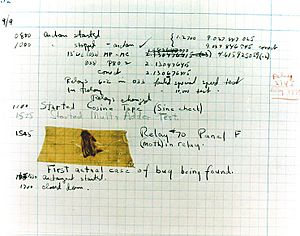Harvard Mark II facts for kids
| Also known as | Aiken Relay Calculator |
|---|---|
| Developer | Howard Aiken and Grace Hopper |
| Release date | 1947 |
| Weight | 25 short tons (23 t) |
| Predecessor | Harvard Mark I |
| Successor | Harvard Mark III |
The Harvard Mark II, also known as the Aiken Relay Calculator, was a very early type of computer. It was built at Harvard University in the United States and finished in 1947. Howard Aiken and Grace Hopper, two important computer pioneers, led the team that created it. The United States Navy paid for the Mark II, and it was used to help calculate how far missiles would travel.
Contents
Building a Faster Computer
Work on the Mark II began in February 1945, after the first Mark I computer was a success. The Mark II was finished and tested in 1947. It was then sent to the US Navy in Virginia in March 1948 and started working fully by the end of that year.
The Mark II was much faster than its older brother, the Mark I. This was because it used special fast switches called electromagnetic relays. The Mark I used slower mechanical counters. The Mark II was a giant machine, weighing about 25 short tons (23 t) (that's like 25 small cars!). It also took up over 4,000 square feet (370 m2) of floor space, which is bigger than many houses.
How the Mark II Processed Information
This computer could add numbers in just 0.125 seconds. It could multiply numbers in 0.750 seconds. This made it more than twice as fast for adding and eight times faster for multiplying compared to the Mark I. It was also one of the first computers to handle numbers with decimal points (like 3.14) automatically. This is called "floating-point hardware."
A cool thing about the Mark II was its built-in ability to do complex math. It could quickly figure out things like square roots, logarithms, and other tricky functions. These calculations took between five and twelve seconds. The Mark II was also made of two smaller computers that could work together. They could check each other's answers or work on different tasks at the same time.
Programming the Mark II
The Mark II, like the Mark I, was not a "stored-program" computer. This means it read its instructions one by one from a special tape. It did not store the whole program inside its memory like modern computers do. This way of separating instructions from data is known as the Harvard architecture.
Programming the Mark II was quite tricky. The tape could only hold eight instructions at a time. What an instruction meant could change depending on when it was run! Each second was divided into different time slots. An instruction might mean one thing in one slot and something else in another. This system worked but made programming complicated and slowed the machine down a bit.
The First Computer "Bug"
The Mark II is famous for something very interesting: it's where the term "computer bug" came from! On September 9, 1947, a real moth flew into the computer's electronics and caused a problem. The team found the insect, taped it into their logbook, and wrote: "first actual case of [a] bug being found." This is why we still call computer errors "bugs" today!
See also
 In Spanish: Harvard Mark II para niños
In Spanish: Harvard Mark II para niños


